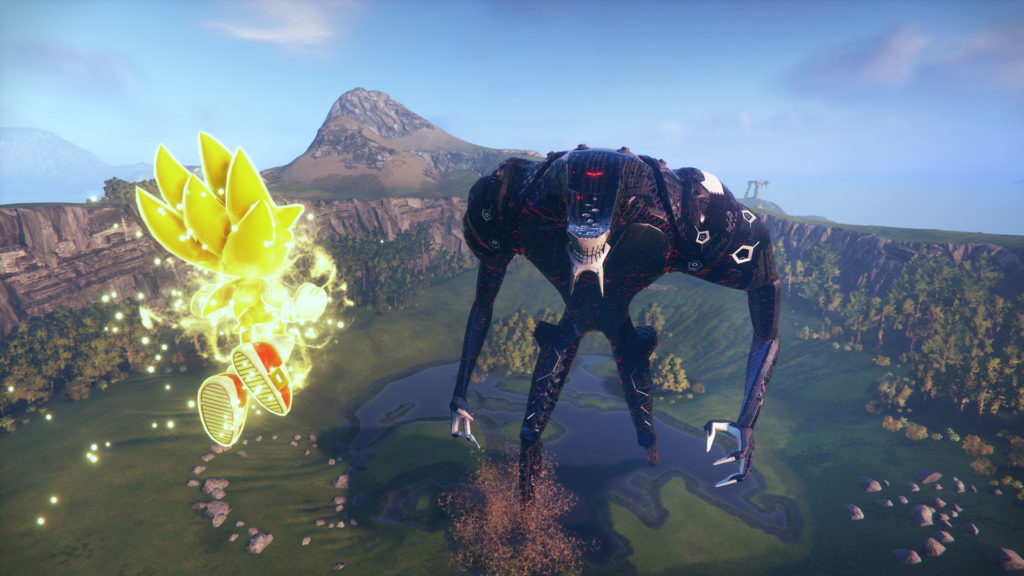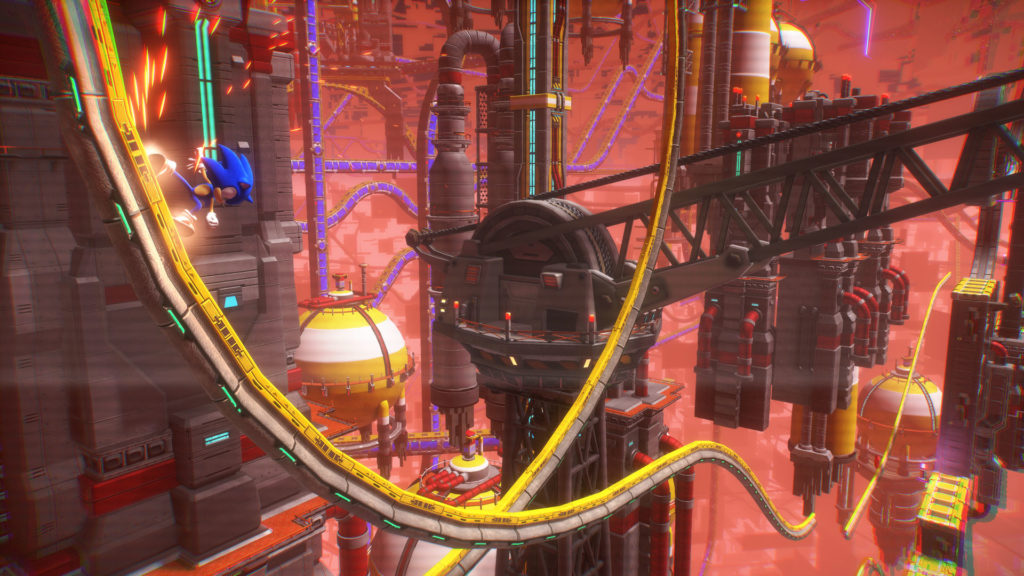
Sonic the Hedgehog didn’t have the successful transition into 3D that the Super Mario Bros. series did. While Super Mario 64 set the standard and remains a fun and engaging game to this day, the same can not be said of most of Sonic’s 3D outings. This is not to say they are all terrible, as the original Sonic Adventure and it’s sequel are well-regarded by many. I don’t have a fond opinion of either but they still at least have redeeming qualities. For my part, the best 3D games were Sonic Generations and Sonic Colours which both released around the same time and combined both 3D and 2D platforming in a unique way. Both games also focused on the titular hero and generally stuck to what works with the former being what I consider to be the best 3D Sonic game ever made. As good as Generations was, even it had some irritating design decisions with the odd mechanics introduced with the final boss making for an anticlimactic end to what had until then been a lot of fun.
Sonic Frontiers is the latest attempt at Sonic in the third dimension after the mediocrity that was 2017’s Sonic Forces. The result, like many previous games, is something of mixture of good and bad. There are some clever ideas and fun moments along with the usual frustrations as well as some downright baffling design decisions. If I had to compare it to any of the previous games, it would be Sonic Adventure which seemed to be designed to include as many features as possible without the developers spending enough time polishing any one of them. Though this is the only area of comparison as they otherwise differ in design.

I have decided to use some images that Sega put on the official website for this review as I played the game on Nintendo Switch which to be as charitable as possible: does not show the game in the best possible light. There is a significant difference in visual fidelity and framerate on the Switch which makes playing it on any other system preferable if you have the option. However, my criticisms of the game have nothing to do with the visuals or the framerate and the much more sluggish performance on Switch while not ideal, was not anywhere near the top of my list of criticisms.
My initial impressions of the game were very positive and I expect most players were similarly impressed. Sonic Frontiers is the first game to include a true open world design. The entire game is still broken into separate maps but even the smallest of these is quite large. These areas are all filled with rails to grind, loop-the-loops, springs and other jump puzzles and platforming sections. To wonder how all these obstacle course got there is to miss the point as they play to the strengths of the gameplay in Sonic series. The open world also allows for plenty of exploration which is an often forgotten staple of the series. Sonic’s trek through Marble Zone in the original game is enough to show that Sonic has never just been about speed — though speed has always been the signature feature.

The transition from 2D to 3D platforming also saw a change in gameplay where item collection became a major objective and this is very true of Sonic Frontiers. Progress is made chiefly by collecting items which include keys and tokens and that unlock story progress and Chaos Emeralds — another series staple. There are thankfully multiple ways to obtain these items as hunting for items in the game world (particularly the tokens), can soon become repetitive. Within the game world there also portals which are unlocked by portal gears. These are similar to the zones found in previous 3D entries, having Sonic progress to the end, collecting rings (including the red star variety) and progressing as fast as possible with an additional key awarded for achieving each objective. These are brief stages based on zones in earlier games like Green Hill and Chemical Plant zones. It is not necessary to play all of them and most are generally forgettable. I wouldn’t be able to identify any one of these after playing through the game.
Meeting collectable requirements is how progress is made in the overworld. In most of the game’s five different overworlds, Sonic has to find his friends who are trapped in “Cyberspace” and appear as fuzzy ghosts that can only converse with Sonic. I want to avoid discussing the plot as it is typically convoluted with the main difference being that Eggman is not the main antagonist. Each encounter with one of his friends whether it be Amy Rose, Tails or Knuckles leads to an in-game cutscene and sometimes a mini-game. This often involves helping little creatures known as Kocos. Success with these minigames will progress the story and sometimes result in Sonic receiving a Chaos Emerald. Obtaining all seven is the main goal for most areas in the game and leads to a boss fight.

This process is repeated in four of the five areas of the game so after every boss fight, Sonic loses the emeralds and must go through a similar process to obtain them again. This is certainly becomes tedious but the mini-games more than the hunt for collectables are what make it so. Each mini-game must be completed to progress. Sometimes they are trivially easy but almost all are a departure from the general gameplay and not very intuitive or refined. Some I failed multiple times before I had time to understand where I went wrong. Some I passed without understanding what I was doing at all.
Probably the worst is one that comes late in the game where Sonic is put into a giant pinball machine and has to achieve a high score to progress. This is hardly unknown to the series but the way it is introduced and it being mandatory for progress did cause frustration. The physics were poor and it was very easy to lose a ball in a way that was beyond the player’s control. The only way to quickly earn a high score is through multipliers which reset after each lost ball. After three balls, it begins all over again. I got through in the end but not without annoyance. I can’t understand why the developers thought to make what are best included as side-activities and not made mandatory for progress.

The developers certainly must have been conscious that obtaining the various collectables would become repetitive and so provided multiple ways to obtain them. The simpler (and strangely the most enjoyable) was going fishing with Big the Cat. A portal to his pond can be found in four of the five areas and while the mechanics are simple, the gameplay is both relaxing and engaging. The various fish are also realistically animated to the point where they clash with the otherwise cartoonish design of Sonic and Big. It is a simple matter to obtain most of the collectables doing this and in one area, I was able to unlock almost everything after spending thirty minutes fishing. This is meant as praise but is all the more damning on the decision to block game progress behind mini-games that are tedious, frustrating or both.
A large portion of the gameplay in Sonic Frontiers that has not yet been mentioned is the combat. Combat throughout most of the Sonic series has been limited to jumping on or spinning through various enemies and has never had much depth. This is not criticism as part of the appeal of the series has always been the simple and intuitive gameplay. In Frontiers, Sonic has a number of different moves that are unlocked through a progression system and a large number of enemies to fight throughout each area that culminates in a fight a boss fight with one of the game’s Titans.

While there is depth, the combat is generally tiresome and most fights have obvious patterns. A stomp move that can be obtained pretty early makes many of these fights simple when used right. The main danger fighting the Titans in particular is running out of rings which deplete while in Super Sonic form. This made my first entry into such a fight particularly annoying as I didn’t have many rings and despite knowing exactly how to attack the Titan, I was soon out of rings and the fight was over. A new move called the ‘Cyloop’ enables Sonic to get extra rings and can be used over and over. So before each fight, it is best to have Sonic run around in circles ten or more times to max out his rings which may be annoying but doesn’t take much time to do. The progression system is mostly irrelevant as I got to the end without being even halfway through improving Sonic’s abilities.
Sonic Frontiers is at its best when Sonic is rocketing through the landscape, traversing obstacles but even the game’s main strength is hampered by some bad design. Many of the obstacle courses and rail slides take Sonic far away from where they appear to be going and it is too easy to inadvertently run into one and have Sonic flung far off the path. Some areas are also annoyingly made inaccessible except by confusing paths — some even inaccessible before certain story conditions are met. A few times during the game when I was making slow progress, a voiceover came through telling me what I should be doing. When this happened, Sonic was frozen in place until it finished and the actual instructions were not helpful at all. This is yet another baffling decision the developers made seemingly without thought as it wasn’t at all necessary to halt gameplay to provide these instructions. Thankfully, the open world gameplay is still more enjoyable than not and certainly the game’s greatest strength.

Sonic Frontiers then is another Sonic game where Sonic Team included a variety of unrefined mechanics instead of narrowing their scope to a few and making them work. It is disappointing because it is obvious this game had a lot of potential that could easily have been realised with better direction. It has some truly exhilarating moments and both the art design and soundtrack are excellent. It even allows the player to select the music while in the overworld and quite a large number of classic tracks from previous games can be unlocked. This is not a terrible game but it is yet another let down considering what it could have been.
